1.Introduction
The main aim of this study is to create a parametric model for High Rise Building, whose ontological modeling was done in the first assignment. Established parametric modeling is a structural designer’s effort to get a better model each time by changing a set of parameters. While making this effort, important High-Performance Criteria were determined for the design, and system development was attempted based on the solution to the problem created by these criteria. In this study, a total of 3 different High-Performance Criteria were determined and 3 different design options were developed based on the solution of these criteria.
2.Chosen System
The chosen system is a reinforced concrete multi-storey High Rise Building, as in the 1st assignment. The chosen system is a system that can be used for commercial or residential purposes and is common in metropolitan areas. Developing such systems on the basis of high-performance criteria for both durability and ergonomics will result in more sustainable results than already existing by providing a higher-performance system that is both more rigid and uses fewer world resources.
2.1. Design Challenge of a Chosen System
To safely carry gravity and lateral loads, high-rise building design essentially entails a conceptual design, approximation analysis, preliminary design, and optimization. The reason why it is important to transport these loads safely is that the vertical load gradually increases due to the horizontal load and mass created by the increasing wind load as the building rises. The design challenge here is to increase the resistance to these loads with different methods while keeping the cost low and keeping the construction of these structures within a reasonable price range.
3. High PerformanceCriteria
The first high-performance criterion is the location of the center of mass of the structure. Keeping the main center of the total mass of the building as low as possible in such high-rise buildings is one of the most important factors for maintaining the rigidity of the structure due to the high wind and earthquake forces that the structure is exposed to. At the same time, while the floors at the bottom of the building should bear the highest load, the fact that the top floors of the building do not need such a load bearing is another reason for the center of mass of the building to be lower. Thus, the floor surface area of the building is expanded and the floor is strengthened, while the ceiling surface area is narrowed and the total load on the ceiling is reduced. The load-bearing capacity of a high-rise building is very important due to the external loads affecting the structure like wind loads and earthquake loads. The total load that this structure can carry can be increased intelligently with different design options. The fact that the structure does not deteriorate as a result of high external forces increases the sustainability of the structure. The construction of imagined structures in today’s world is proportional to the reasonable cost of these structures. Especially since such high-rise buildings are used as either commercial or residential, the construction of these buildings is usually profit-oriented. That is why I believe also I should consider this as a High-Performance-Criterion.
4. Engineering Rationale
The building is a classic reinforced concrete high-rise building. While evaluating the system, only the superstructure of the system was evaluated. The foundation of the system was not included in the design and evaluation. While the building is being developed, ceiling width and ceiling length are added as parameters because sometimes the ceiling dimensions of the building change as well. In order to have close evaluations, the total heights and floor numbers of the buildings were kept constant. In some designs, while the floor area is fixed, the number of elevators has also changed for better space management due to the change of the ceiling area. While offering different solutions to the structure, additional elements were added to the structure like steel X-Bracings. Since these beams are steel, they increase the cost very seriously and also increase the load-bearing capacity of the structure. Dimensions of these beams are not added as parameters. The logic of this parametric modeling is to design different options to construct the High Rise Building, which has the most cost-effectiveness and the highest strength, and to choose the most suitable one among these options. The main parameters used in the design of this building can be seen down below in the design space section.
5. Design Space
The parametric evaluation of 3 possible solution proposal designs can be seen in the table given below.
Figures of the models can be seen also here.
6.Results
According to the data we have, we see that no single model unfortunately has the best value in all High-Performance-Criteria. However, if we look at the 2nd Design option, it can be said that the 2nd Design Option is the most logical option to pick since this system is the most successful in terms of cost and the 2nd most successful design in terms of loadbearing capacity. If we rank the design options according to the results of the given parameters, we can list them as follows;
1- Design Option 2
2- Design Option 3
3- Design Option 1
Download the parametric models here: Option1 Option2 Option3
References
Mironova, J. (2020, July). Wind impact on low-rise buildings when placing high-rises into the existing development. In IOP Conference Series: Materials Science and Engineering (Vol. 890, No. 1, p. 012055). IOP Publishing.
Ezoddin, Alireza & Kheyroddin, Ali. (2018). Study on the Effect of the Position of X-bracing Arrangement in the Steel Structures with a Triangular Plan. SIAM Journal on Numerical Analysis. 2. 2. 10.29252/nmce.2.2.11.
Lucian Ungereanu. “Bridge Tutorial- Parametric model generation with Dynamo”. In: (2020).
Sabouri-Ghomi, S., & Ebadi, P. (2008, October). Concept improvement of behavior of X-Bracing systems by using Easy-Going Steel. In The 14th World Conference on Earthquake Engineering, October (pp. 12-17).
Králik, E. J., & Kralik, J. (2013). Probability assessment of analysis of high-rise buildings seismic resistance. In Advanced Materials Research (Vol. 712, pp. 929-936). Trans Tech Publications Ltd.
Go to the Ontology: High Rise Building 1: Ontological Modelling
Go to the combined System: Sports Facility Center: Combined Parametric Modelling

